|
Page 2 Go To Page:
[
1
] [ 3 ] [ 4
]
[ 5 ]
[
6 ]
[ 7 ]
[ 8 ] |
|

|
Cost
|
Item
Description
|
Click Picture
for Larger Image
|
|

|
$25.00 |
M200b
This is a very nice Barite and Calcite combination specimen on a matrix.
This very cool specimen has well defined dark Honey Golden colored Barite Crystals
mixed in with the matrix. The lovely Barite crystal on one side is
almost 2" long
and the specimen overall measures 1" x almost 1" x over
1 1/8" and has a nice natural appearance.
The tip of the large crystal is not perfect and is reflected in our price. This interesting specimen is from Meade County of South Dakota.
Another photo
Another photo
Another photo
Barite is a mineral consisting of Barium sulfate and is generally white
or colorless. It is used in the manufacture of paints and paper.
Although Barite contains a 'heavy' metal, Barium, it is not considered to
be a toxic chemical because of its extreme insolubility.
Calcite is a Carbonate mineral that is most widely distributed on the Earth's
surface. It is a common constituent of sedimentary rocks with Limestone
in particular. A Calcite formation can take on many different shapes
and sizes which is dependent on the location, ground water occurrence and
temperature. Calcite is usually white or colorless but can be gray,
red, yellow, green, blue, violet, brown or black. The deeper the color
is usually indicative of the definitive impurities from the earth or water. |
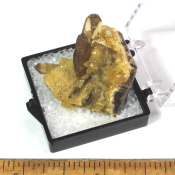
South Dakota Barite
|
|

|
$24.00 |
M201b
This is a splendid Spanish Pyrite specimen from the Navajun Mine, Piritas De Navajus S.L., Spain.
This very interesting specimen has an excellent quality Pyrite cube in
matrix. The shiny Pyrite
cube measures approximately 5/8" x 3/4". The entire specimen measures
2 1/4" x 2
1/8" x 1 7/8". Very, very cool!!
Another photo
Another photo
Another photo
Another photo
Pyrite, or Iron Pyrite, is an Iron sulfide with isometric Crystals that
usually appear as cubes. It is brittle and can break or powder easily.
Its metallic luster and brass yellow hue have earned it the nickname of "fool's
gold" due to many miners mistaken it for the real thing. Ironically,
small quantities of actual gold are sometimes found in Pyrite. It is
the most common of the sulfide minerals and is usually found with other sulfides
or oxides in Quartz veins, sedimentary or metamorphic rocks.
|
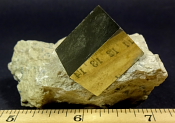
Pyrite
|
|

|
$90.00 |
M202c
Here is something very different; an exceptional Quartz Cluster from
Madagascar. It has a fabulous array of different sized crystals
protruding in all directions in a captivating design. It measures 6 7/8" x
7" x
3 5/8" and has not been polished. Very cool! Another photo
Another photo
Another photo
Another photo
Quartz is the second most common mineral in the Earth's continental
crust. It is mainly composed of Silica or Silica based minerals.
Although Quartz is known by a variety of names, the most important distinction
between types of Quartz is that of macro-crystalline, individual crystals
visible to the unaided eye, and micro-crystalline, where aggregates of crystals
are only visible under high magnification. There are many forms of Quartz
including Chalcedony, Amethyst, Citrine, and Carnelian which are results of
mineral impurities or heat treatments. |
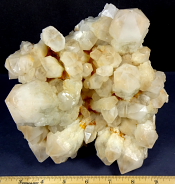
Quartz Cluster
|
|

|
$20.00 |
M203c
This is a
very nice specimen with bright yellow Sulfur crystals. It
measures 3 1/4" x 2 1/4" x 1 1/4" and has not been polished.
This excellent Sulfur specimen has very nicely defined and sparkly
crystals. This material is from Durango, Mexico.
Another photo
Another photo
Another photo
Another photo
Crystals of Sulfur are usually yellow to yellowish-brown blocky dipyramids.
Also it is found more typically as powdery yellow coatings. Native Sulphur
is usually formed from volcanic action - as a sublimate from volcanic gasses
associated with Realgar, cinnabar and other minerals. It is found in
some vein deposits as an alteration product of sulfide minerals.
|
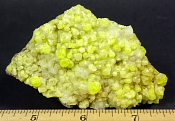
Sulfur
|
|

|
$45.00 |
M204b
Here is a very nice Green Tourmaline in Quartz specimen from Brazil.
This interesting specimen measures 2 7/8" x 1 3/4" x
2 1/2" and has awesome sparkly large Green colored crystal measuring
approximately 2 3/8" x 3/4". Very nice.
Another photo
Another photo
Another photo
Another photo
The Tourmaline mineral group is chemically one of the most
complicated groups of Silicate minerals. Its composition varies widely
with Sodium, Calcium, Iron, Magnesium, Lithium, Aluminum, Boron and other
elements. It has a wide variety of colors including black, blue-black,
brown, yellow, red, green, pink and is rarely colorless. This mineral is
found in igneous rocks, like Granite Pegmatite, and metamorphic rocks such
as Schist and Marble.
|
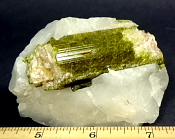
Green Tourmaline
|
|

|
$28.00 |
M205b
This is a nice specimen of natural Copper from Ray Mine Pinal County
Arizona. This is natural native copper which has been mostly removed from
the matrix rock which was surrounding it. There is matrix rock visible in
some areas of the specimen. It measures 1 7/8" x 1 3/4" x 1 1/4". Very
nice.
Another photo
Another photo
Another photo
Click
here to view more Copper specimens !!
Copper is a reddish colored metal with a high electrical and thermal
conductivity. It has its characteristic color because it reflects red
and orange light and absorbs other frequencies in the visible spectrum due
to its band structure. It is in the same family as Silver and Gold and
is a malleable metal. It is beautiful natural or polished.
|
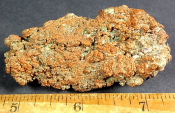
Natural Copper
|
 |
$20.00 |
M206b
This is a very nice
Galena specimen with lots of character and design. It measures 1 1/2" x
3
1/8" x
1 3/8" and has a natural shiny appearance. The mineral is quite
heavy for it's size as it falls into the heavy metal category of minerals.
This very cool specimen weighs nearly 1/2 pound.
Another photo
Another photo
Another photo
Another photo
Galena is the natural mineral form of Lead Sulfide. It is the
most important Lead ore mineral and is one of the most abundant and widely
distributed sulfide minerals. It is often associated with Sphalerite,
Calcite and Fluorite. Galena deposits often contain significant amounts
of Silver, Zinc, Cadmium, Antimony Arsenic and Bismuth. It is used as
a semiconductor in early wireless communicatcon systems. It is usually
dark grey to black in color with a shiny iridescence.
|
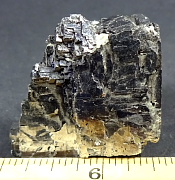
Galena
|
 |
$35.00 |
M207b
This nicely polished Septarian Slab is from Utah. It measures
6 3/4" x
6 1/8" x 1/2" thick and has been nicely polished on the
front face. This Septarian Nodule slab has beautiful Yellow Calcite
bordered with pretty brown Aragonite and even some subtle "rainbow" reflections
in the crystal. A definite beauty to behold.
Another photo
Another photo
Another photo
Another photo
Click
Here to See More Septarian Specimens.
Septarians are commonly composed of a carbonate mineral such as Calcite,
a microcrystalline form of Silica as in Flint or Jasper, or an Iron Oxide
such as Hematite. These specimens are also known as a concretion which
is a type of sedimentary rock. Septarians were formed millions of years ago by sediment forming around
a fossil to create a mud ball transforming the fossil into Calcite and Aragonite.
|
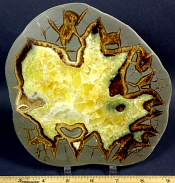
Septarian Slab
|
|

|
$80.00 |
M208c
Here's an absolutely stunning Crystal Quartz Cluster from Brazil. It
measures 6 1/2" x 5" x 1" and has a natural finish. It has seemingly
endless crystals in various sizes pointing in all direction giving it a
great appearance! The crystals have exceptional clarity and abundant
"rainbow" reflections to add to it's fabulous character. The crystals have
the appearance of being compressed still amazingly all in tact.
DISCLAIMER:
This does have delicate crystals and although we have had great success
in shipping such delicate items it may have some smaller crystals come
loose and fall off during shipping. This is unavoidable but rest assured
there are still plenty of amazing crystals to enjoy. Grab this beauty quick!
Another photo
Another photo
Another photo
Another photo
Quartz is the second most common mineral in the Earth's continental
crust. It is mainly composed of Silica or Silica based minerals.
Although Quartz is known by a variety of names, the most important distinction
between types of Quartz is that of macro-crystalline, individual crystals
visible to the unaided eye, and micro-crystalline, where aggregates of crystals
are only visible under high magnification. There are many forms of Quartz
including Chalcedony, Amethyst, Citrine, and Carnelian which are results of
mineral impurities or heat treatments.
|
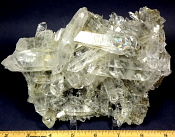
Crystal Quartz
|
|

|
$65.00 |
M209c
Here is an outstanding specimen of Apophyllite Crystals with
Stilbite. This
beauty is a one of a kind, very well defined specimen with the sparkly
nearly clear Apophyllite crystals that will not be duplicated. It
measures 5 1/4" x 3" x 1 1/4" and has a natural sparkly finish. It
even has pretty "rainbow" reflections in the crystal. This
material is from Jalgaon, India. Just very nice!!
Another photo
Another photo
Another photo
Another photo
Apophyllite, a Zeolite, is Silicate mineral with very well defined clear
Crystals and is very popular as a collector's mineral. The Crystal structure
will refract like in obvious rainbows and can form "natural pyramids" when
tumbled.
Stilbite is another Silicate mineral from the Zeolite family. It is
often characterized by its sheaf like aggregates. The color is usually
white or pink and when the cleavage is perfect, will have a distinct
pearly luster.
|
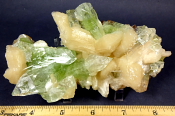
Apophyllite Stilbite
|
|

|
$40.00 |
M210c
This is a nice Smokey Quartz cluster specimen with multiple tips of
various different sizes. It measures almost 5 3/8" x
2 5/8" x over 2 1/8" and has a pretty sparkly appearance.
Most of the tips are very nice but there are some broken crystals, typical
for this material.
This beautiful specimen is from Brazil. Very, very
nice!
Another photo
Another photo
Another photo
Quartz is the second most common mineral in the Earth's continental
crust. It is mainly composed of Silica or Silica based minerals.
Although Quartz is known by a variety of names, the most important distinction
between types of Quartz is that of macro-crystalline, individual crystals
visible to the unaided eye, and micro-crystalline, where aggregates of crystals
are only visible under high magnification. There are many forms of Quartz
including Chalcedony, Amethyst, Citrine, and Carnelian which are results of
mineral impurities or heat treatments.
|
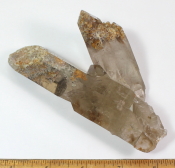
Smokey Quartz
|
|

|
$55.00 |
M211b
Here is a very nice Dog Tooth Calcite Crystal. It measures
8 7/8"
x almost 4 1/4" x 2 1/2" and has an all natural exterior. This
specimen has many sharply pointed Crystal points with Pinkish Brown tinted pyramid-shaped centers
and an iridescent shine. There are also tiny clear crystals on much
of it that provides a "frosted" look. A super gift.
Another photo
Another photo
Another photo
Another photo
Calcite is a Carbonate mineral that is most widely distributed on the Earth's
surface. It is a common constituent of sedimentary rocks with Limestone
in particular. A Calcite formation can take on many different shapes
and sizes which is dependent on the location, ground water occurrence and
temperature. Calcite is usually white or colorless but can be gray,
red, yellow, green, blue, violet, brown or black. The deeper the color
is usually indicative of the definitive impurities from the earth or water.
|
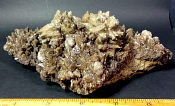
Dog Tooth Calcite
|
 |
$75.00 |
M212c
Here is something very
different at the Rock Shed. This is a high quality specimen of
Fluorite in a matrix from China. The pretty Aqua Green Fluorite crystals
of various sizes are scattered about the matrix.
The lovely specimen measures almost 3 5/8" x
nearly 2 7/8" x almost 2 1/8" and has its own natural shine in areas. This all
natural mineral has an unique character and makes a great addition to your
collection.
Another photo
Another photo
Another photo
Another photo
Fluorite, also referred to as fluor-spar, is a mineral composed of Calcium
Fluoride. It is a widely occurring mineral found world wide and is often
found with metallic minerals such as Galena, Sphalerite, Barite, Quartz
and Calcite. Fluorite may fluoresce strongly in ultraviolet light
which may be due to the presence of some impurities such as Yttrium.
Blue is the most common color but red, purple, green, yellow and white are
also frequent. It can be used in high performance telescopes, camera
lens, enamels and in the making of opalescent glass.
|
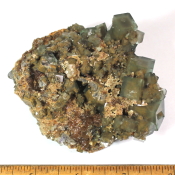
Fluorite
|
|

|
$22.00 |
M213b
Here is an outstanding and interesting combination specimen of Silicon
Carbide. This unique mineral has well defined dark Crystals of different
sizes in opposite sides with a sparkly Green, Blue and Purple sheen in the light
that changes from different directions. It measures 7 1/2" x 2
1/4" x
2" and has an all natural texture and finish. It is very
difficult to capture the full brilliance of the diverse colors but it is
very colorful and sparkly. This is a one-of-a-kind mineral for the one-of-a-kind mineral collector
and something very different!
Another photo
Another photo
Another photo
Another photo
Silicon carbide, also known as
carborundum, is a compound of silicon and carbon and occurs naturally as
ultra rare moissanite. Silicon carbide powder has been mass-produced since
1893 for use as an abrasive. Grains of silicon carbide can be bonded
together by sintering to form very hard ceramics widely used in
applications requiring high endurance, like as car brakes or ceramic
plates in bulletproof vests. Electronic applications of silicon carbide as
light emitting diodes and detectors began over 100 years ago and continue
today are widely used in high-temperature/high-voltage semiconductor
electronics. Large single crystals of silicon carbide can be grown by the
Lely method; they can be cut into gems known as "synthetic moissanite".
|
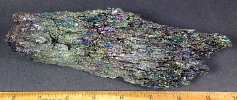
Silicon Carbide
|
|

|
$50.00 |
M214c Here is a
rather unique find at the Rock Shed. This is a very large Tourmaline
in a bed of beautiful Quartz from Madagascar. It measures 7" x 3
3/4" x 6 3/4" and weighs nearly 7 pounds. Very Nice!
Another photo
Another photo
Another photo
Another photo
Quartz is the second most common mineral in the Earth's
continental crust. It is mainly composed of Silica or Silica based
minerals. Although Quartz is known by a variety of names, the most
important distinction between types of Quartz is that of
macro-crystalline, individual crystals visible to the unaided eye, and
micro-crystalline, where aggregates of crystals are only visible under
high magnification. There are many forms of Quartz including Chalcedony,
Amethyst, Citrine, and Carnelian which are results of mineral impurities
or heat treatments.
The Tourmaline mineral group is chemically one of the most
complicated groups of Silicate minerals. Its composition varies widely
with Sodium, Calcium, Iron, Magnesium, Lithium, Aluminum, Boron and other
elements. It has a wide variety of colors including black, blue-black,
brown, yellow, red, green, pink and is rarely colorless. This mineral is
found in igneous rocks, like Granite Pegmatite, and metamorphic rocks such
as Schist and Marble.
|
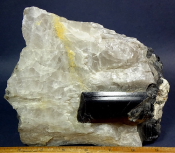
Quartz Tourmaline
|
|

|
$24.00 |
M215c
Here is something very different! This is a lovely
specimen of Thomsonite on a matrix. It has a pretty
beige color. This
rarer specimen measures
2 1/2" x 2 3/8" x 1 3/4". This very interesting piece comes
from India and would complete any serious collection.
Another photo
Another photo
Another photo
Another photo
Thomsonite is an uncommon and desirable member of the Zeolite group,
forming in unique and interesting crystal aggregates. Thomsonite was
first identified in material from Scotland in 1820 and is named for the
Scottish chemist Thomas Thomson. The crystals tend to be long thin
blades that typically form radial aggregates, and sometimes fans and
tufts. The aggregates are variable and may be spikey in appearance, dense
and ball-like, or form worm-like growths. Tight acicular radiating
clusters and sphericules are common forms.
|
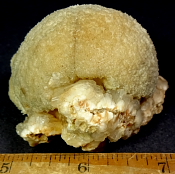
Thomsonite
|
|

|
$16.00 |
M216b Here is something different for the mineral collector. This is
a very nice specimen of Wavellite crystals in matrix and is from Arkansas.
This interesting mineral measures 2 3/8" x 1 3/4" x 7/8". A really different mineral for the mineral
collector. Very cool!
Another photo
Another photo
Another photo
Another photo
Chemically, Wavellite is Hydrated Aluminum Phosphate Hydroxide.
It is a secondary mineral found most often in aluminous, low-grade metamorphic
rocks. Normally it forms as radiating "starburst" clusters of green to yellow-green
crystals. It will show its fibrous structure on fracture surfaces in the matrix.
|

Wavellite
|
|

|
$70.00 |
M217c Here
is a exceptionally nice Green Epidote specimen from
Brazil. It has very nice Green Epidote crystals of different
sizes and pointing in all different directions. This very interesting and
pretty specimen measures 4 1/2" x 3" x 1 3/4" tall. Very
nice. Another photo
Another photo
Another photo
Another photo
Epidote is an abundant rock-forming mineral, but one of the
secondary origin. Many of the characters of the mineral vary with the
amount of iron present. Prismatic, columnar crystals, often shiny, finely
striated faces. The color is green, gray, brown or nearly black but
usually a characteristic shade of yellowish-green or pistachio green.
|
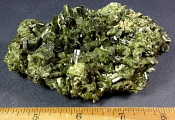
Epidote
|
|

|
$10.00 |
M218c Here
is a new and different item at the Rock Shed. This a very nice, very
interesting Rosasite and Limonite specimen from Mapimi, Mexico. It has a
very pretty Aqua blue Rosasite on the Limonite matrix. This fantastic
mineral measures 1 1/2" x 1 1/4" x 1" and has a super natural
appearance. A great way to begin your mineral collection!!
Another photo
Another photo
Rosasite is an uncommon mineral belonging to the Carbonate group of
minerals. It has a minor potential for use as zinc or copper ore as is
typically associated with Copper deposits including Limestone which is the
source of the Carbonate.
|
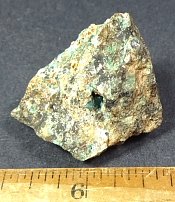
Rosasite
|
|

|
$35.00 |
M219c
This is a very different and pretty specimen of a gorgeous vibrant Blue
Cavansite Crystal on matrix. This unique and rare specimen measures 1 1/2" x
1 1/2" x 1 1/4" thick and would be a good addition to any
collection. This material is from Pune, India. Very nice.
Another photo
Another photo
Another photo
Another photo
Cavansite is a deep blue hydrous calcium vanadium phyllosilicate
mineral, occurring as a secondary mineral in variety of zeolite minerals.
|
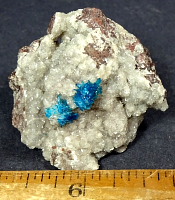
Cavansite
|
|

|
$20.00 |
M220b
This is a unique mineral specimen of Fluorite with Pyrite from The Minerva
Mine #1 in Harden County, Illinois. This lovely specimen measures 2 1/2"
x 1 1/2" x 1/8 . Very nice!
Another photo
Another photo
Another photo
Another photo
Fluorite, also referred to as fluor-spar, is a mineral composed of Calcium
Fluoride. It is a widely occurring mineral found world wide and is often
found with metallic minerals such as Galena, Sphalerite, Barite, Quartz
and Calcite. Fluorite may fluoresce strongly in ultraviolet light
which may be due to the presence of some impurities such as Yttrium.
Blue is the most common color but red, purple, green, yellow and white are
also frequent. It can be used in high performance telescopes, camera
lens, enamels and in the making of opalescent glass.
|
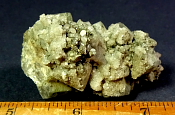
Fluorite - Pyrite
|
|

|
$35.00 |
M252b
A nice specimen of natural Copper from Keweenaw Peninsula, Michigan. This
is natural native copper which has been mostly removed from the matrix
rock which was surrounding it. It measures 4 1/8" x 2 5/8"
x 1 3/4" thick; weighs nearly 1 1/4 pounds and has a natural rough exterior.
Another photo
Another photo
Another photo
Click
here to view more Copper specimens !!
Copper is a reddish colored metal with a high electrical and thermal
conductivity. It has its characteristic color because it reflects red
and orange light and absorbs other frequencies in the visible spectrum due
to its band structure. It is in the same family as Silver and Gold and
is a malleable metal. It is beautiful natural or polished.
|
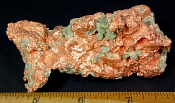
Copper
|